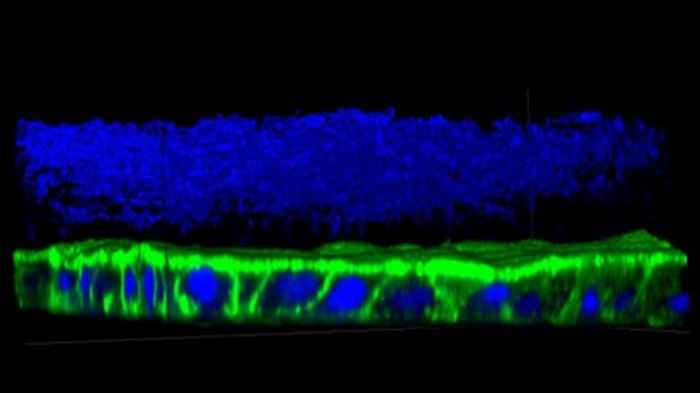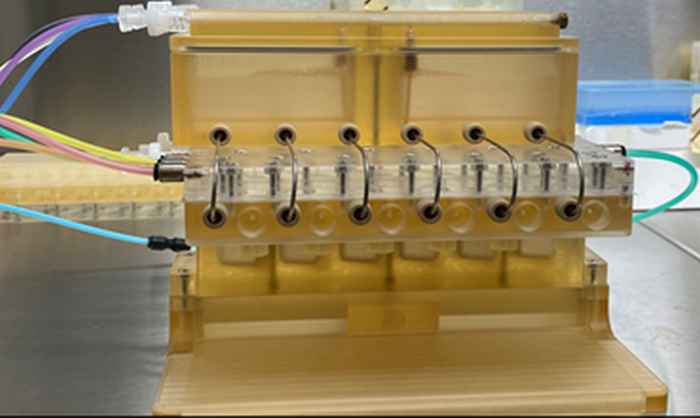Animal-free miniature gut model for microbiome research
16 September 2025
There is increasingly more research into our gut microbiome, as it appears to play an important role in diseases like obesity, inflammatory bowel disease, and diabetes. However, studying the adult gut microbiota is challenging, because it mostly consists of anaerobic bacteria, which live in oxygen-poor environments. ‘It's a well-known problem that there are limited options to study these anaerobes,’ says Jianbo Zhang, Assistant Professor at our Swammerdam Institute for Life Sciences.
Researchers typically use germ-free mice to study the function of gut microbiota on their host. Since this is a difficult process and there is a shift towards animal-free research, scientists are looking for alternatives. Zhang: ‘During my PhD, I became very interested in studying the microbiome, but I was concerned about animal experiments.’ After his PhD, he joined Linda Griffith's lab at MIT, who was developing an animal-free miniature gut system called the GuMI platform.
GuMI platform
The GuMI platform is a device that creates a microenvironment for both anaerobic bacteria and human epithelial cells. The device has two compartments, with an oxygen-poor environment for the bacteria and an oxygenated environment for the human cells. For both sides, conditions like the nutrients and pH are controlled.
Zhang mostly worked on developing cell culture methods and the medium suited for all cell types. Together with his MIT colleagues, he also came up with relevant biological questions that can be answered using the platform.
Bringing to UvA
After publishing a flagship paper about the GuMI platform, the device company CN Bio Innovations was interested and licensed a patent for the system. In 2021, Zhang was able to set up the GuMI platform at UvA, where he could establish his own lab embedded in the department led by Professor Stanley Brul. Apart from the device, Zhang also brought all his knowledge on co-culturing bacteria and human cells.
Zhang's lab at the UvA is one of a few labs around the world that has shown they can culture oxygen sensitive bacteria successfully.
Although the field is moving forward, culturing oxygen sensitive bacteria is still very challenging. Zhang's lab at the UvA is one of a few labs around the world that has shown they can do this successfully. Zhang: 'During the development of the GuMI system at MIT, my colleague consulted top microbiome scientists. They said: “Don't even try, it's a waste of your time.” I didn't know of this conversation and tried to culture these bacteria anyway. We had a lot of difficulties, but eventually we succeeded.’


Testing probiotics
Although the current version of the GuMI platform doesn't fully capture the complexity of the adult gut microbiome, it can already be used for various applications, like testing probiotics. Zhang: ‘We have two public-private partnership projects, one with DSM-Firmenich and one with a startup company in Switzerland, SURI BioTech. These companies both produce probiotic supplements. We use the GuMI platform to test how their products or product candidates can, for example, boost immunity.’
Zhang is also part of NWO MetaHealth, a consortium focused on studying metabolic and oral health in children. Recently, Zhang received an ERC starting grant, in which his team will establish a germ-free infant gut and use it to investigate the impact of dietary and early bacterial residents on the function of infant gut microbiota, the mucosal barrier, and immune cells.
Future applications
In the future, Zhang envisions a wide range of applications for the GuMI platform. ‘I can imagine it being used by pharmaceutical companies or for nutritional and live bacteria testing. While the GuMI platform would not be a replacement for animal models in the healthcare sector, it could be useful as an additional option.’
The GuMI system may also be valuable for personalized treatments of patients. Zhang is working on incorporating immune cells into the system to study immune development, particularly in the context of inflammatory bowel diseases. Zhang explains: ‘In the distant future, if we can get patient tissue, we might be able to use the GuMI platform to understand why some patients respond to a certain therapy while others do not. This information could be used for patient-specific medicine or nutrition.’